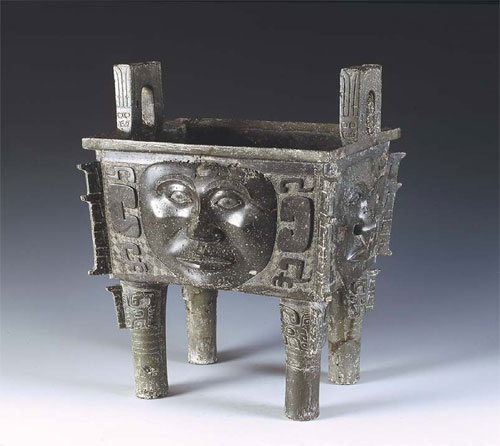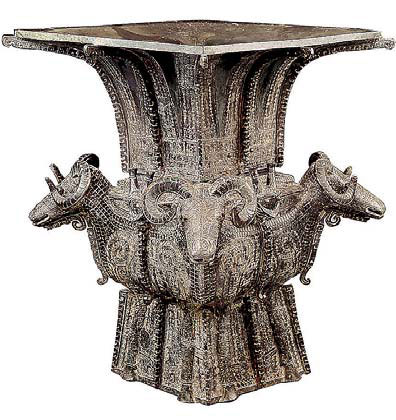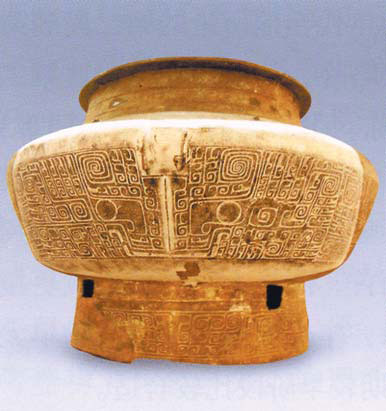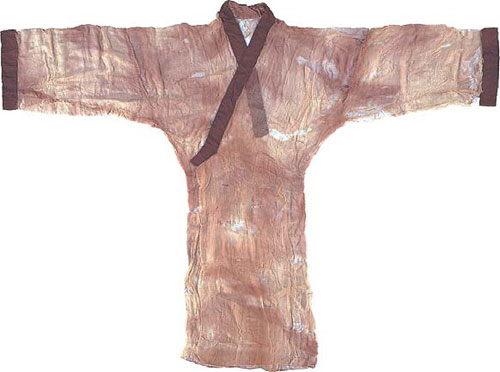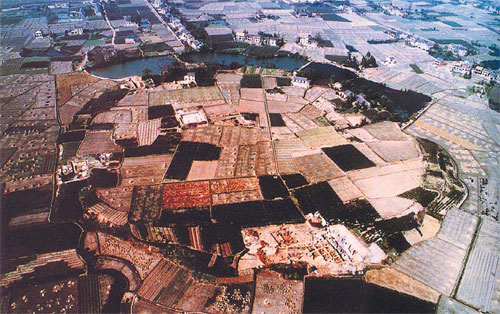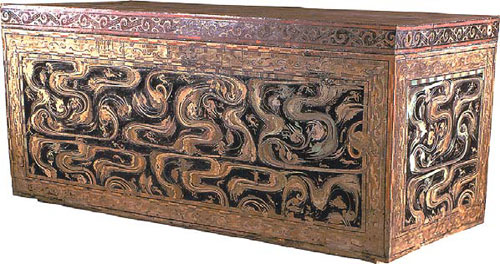Province's rich history recorded in relics
The long history of Hunan province in Central China has left the region with many relic items and sites.
Hunan Provincial Museum alone has more than 180,000 relic pieces, according to Yu Yaojiao, a researcher at the museum. The museum's collection and other relics scattered throughout the province testify to Hunan's rich history and culture.
Rice-planting civilization
Hunan is well known as a productive agricultural area through China's history and used to be called "the land of fish and rice". It has an ideal climate and soil conditions for growing rice.
In 1995, four rice grains dating back more than 10,000 years were excavated at Yuchanyan site in Daoxian county. In 2004, six more grains from the same period were discovered by a China-US joint excavation team at the site.
Archaeological findings over the past years show that wild rice localities existed in different regions of the province.
In 1988, a huge amount of rice husks were found amid pieces of pottery at the Pengtoushan site in Lixian county, in Changde. At another site in Lixian, nearly 10,000 carbonized rice grains that dated back about 8,000 years were unearthed in 1995.
In 1996, at the Chengtoushan ruins in Lixian county, scientists discovered rice paddies that date back about 6,500 years, and are the earliest of their kind discovered anywhere in the world.
In 2006, a large amount of carbonized rice husks and a complete irrigation system were discovered in Lixian's Jijiaocheng site, which dated back about 4,000 years.
The findings prove that ancient residents of Hunan had rice-based agriculture in the prehistoric period.
Bronze culture
According to Yu, items of bronzeware from the Shang and Zhou dynasties (c.16th century-256BC) have been excavated at the Tanheli site and neighboring areas in Ningxiang county in Changsha, the capital of Hunan, since the 1930s.
The excavation findings are proof that the bronze culture that originated in the Central Plains had been introduced to Hunan at that time.
The excavated bronze pieces, including a famous square zun (a wine vessel) decorated with the heads of four goats, and a piece known as a square ding (a cooking vessel) designed with human faces, are exclusively referred to as the "Ningxiang Bronzeware Group" in the archaeological circle.
In recent years, many unique bronze pieces, including a wine vessel called the Min Fanglei, were discovered in Hunan province.
The bronze vessel has been considered the best of its kind since its discovery in 1919. The 3,000-year-old piece returned to Hunan last year from overseas and is now in the Hunan Provincial Museum.
A bronze bu (a jar for wine and water) with stylized animal faces, which is also regarded as the best of its kind, and a giant bronze nao (a gong) with elephant patterns, which is believed to be the oldest percussion instrument discovered in China so far, were among the important items of bronzeware excavated in the province.
Items of bronzeware discovered in Hunan have unique shapes, which are often vivid and exquisite.
The bronze pieces often feature an animal or several kinds of animals together, such as pigs, elephants, oxen and sheep.
Their styles are very different from those excavated in the Central Plains and bear clear marks of cultural blending of the Central Plains residents and indigenous tribes in Hunan.
Mawangdui Tombs
The unearthing of Changsha's Mawangdui Western Han Dynasty (206BC-AD24) Tombs swept the world as an astonishing excavation discovery in China's archaeological history.
The three Han tombs were excavated during 1972 and 1974, with more than 3,000 relic pieces unearthed.
All the pieces are regarded as treasures and serve as important references to the social development of the early Han Dynasty.
Among them, more than 700 pieces of well-preserved lacquerware have encouraged some historians to propose the idea of a "lacquer age".
Delicate and bright silk pieces excavated there are also testimony to China's long history of silk producing.
A plain silk gauze garment unearthed, which weighed only 48 grams, is the earliest and thinnest of its kind to be discovered in the country.
Some wood figures featuring musicians are thought to be the earliest depictions of family bands in China.
A silk book named Prescriptions of Fifty-two Diseases is believed to be the earliest and most complete ancient Chinese medical prescription book. A painted scroll demonstrates the earliest gymnastic exercises known in the world so far, and another two books are thought to be the earliest texts found about astronomy.
Other important excavations include two maps about the terrain and the garrison forces in the southern part of the ancient Changsha Kingdom. They are regarded as milestones in the world's history of cartography.
A lacquered coffin with colored patterns on a black base is the biggest lacquer piece ever excavated in China.
A female mummy excavated from one of the tombs is unprecedented in the history of world archaeology .
Kept in Hunan Provincial Museum since its excavation, the mummy is said to be that of Xin Zhui, wife of the prime minister of the Changsha Kingdom during the early Western Han Dynasty, 2,000 years ago. The mummified woman is thought to have died at the age of 50.
The female corpse still had intact hairs and flexible muscles when unearthed. Unlike mummies excavated in Egypt, it is the only wet corpse from ancient times. It is believed to have unique scientific value because a wet mummy retains more DNA information about its owner than dry mummies.
With the development of technology, scientists in the future can learn more about people who lived during the Western Han Dynasty by studying the DNA information.
Records on bamboo strips
According to Yu from the museum, Hunan has excavated the largest number of ancient bamboo strips, on which people wrote before the invention of paper.
The bamboo strips cover a long period of time and record diverse contents, which is rare.
More than 36,000 pieces of bamboo strip records from the Qin Dynasty (221-206 BC) were unearthed in Liye Ancient Town in Hunan's Longshan county in 2002, which give many social details about the dynasty.
As the earliest centralized feudal state in China's history, very limited records about the dynasty's administrative system have been preserved. The bamboo strips in Liye are regarded as having extremely important historical value.
In 1996, a group of bamboo strips with writing on them that date back to the Wu Kingdom of the Three Kingdoms (AD220-280) were unearthed at a construction site near May First Square in central Changsha.
The bamboo strips, totaling more than 100,000 pieces, were the largest excavation of their kind last century.
Most of the bamboo strips were written between AD 196 and 237. They have important reference value for studying laws and regulations of the land, tax, and legal systems of the short-lived Wu Kingdom.
fengzhiwei@chinadaily.com.cn
|
A bronze ding (a cooking vessel) from the Shang and Zhou dynasties designed with human faces. |
|
A square bronze zun (a wine vessel) decorated with the heads of four goats. |
|
A bronze bu (a jar for wine and water) with stylized animal faces is regarded as the best of its kind. |
|
A plain silk gauze garment, which weighs only 48 grams, is the earliest and thinnest of its kind to be discovered in the country. |
|
Hunan has excavated the largest number of writings on ancient bamboo strips. |
|
Scientists discovered rice paddies that date back about 6,500 years at the Chengtoushan ruins. |
|
More than 700 pieces of well-preserved lacquerware unearthed in Han tombs have encouraged some historians to propose the idea of a "lacquer age". Photos Provided to China Daily |
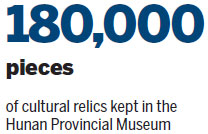
(China Daily 04/28/2015 page12)


